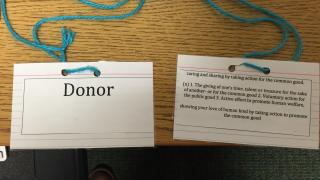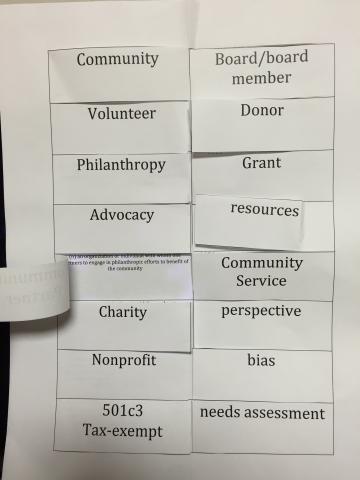The Vocabulary of Philanthropy
Play matching games on teams to gain familiarity with terms associated with philanthropy.
Author: Urban EdVenture Faculty
The learners will
- develop familiarity with the vocabulary of philanthropy.
- communicate and collaborate through teamwork.
- timer
- vocabulary necklaces (yarn, 2 index cards per necklace, vocabulary words and definitions)
- copies of the Vocabulary Study Tool
- glue sticks
- scissors
- Choose vocabulary terms (and definitions) you want youth to learn, or use the terms and definitions below (and on the handout).
- Create vocabulary necklaces. The number of vocabulary words should match the number of participants. The term and definition are on separate cards. Each necklace is made of a piece of yarn with two index cards. Each necklace contains a vocabulary word and a definition for a different word. Use a hole punch to make two holes at the top of each card. Make the necklaces so that the word card and definition card slide on the yarn so that the student can hang the vocabulary word on their chest and the definition card on their back (the person behind them can read it) when wearing the necklace. The youth will stand in a complete circle if all definitions and vocabulary are matched correctly.
- If you do not use the provided vocabulary, create your own version of a study tool based on the vocabulary terms you chose and photocopy it, Construct an example study tool from the handout. cut on the lines of the vocabulary page to create lift-a-flap windows. The definitions will match the terms when the pages are attached.
The following are key terms in preparation for the work ahead in this class.
- 501(c)(3) Tax-exempt (n): A classification given to an organization that is "exclusively educational and charitable" and states that the organization is exempt from paying taxes. Tax-exempt status is issued by the Internal Revenue Service, an agency that is part of the Federal government.
- Advocacy (n): The act or process of writing or speaking in favor of, or supporting, a cause.
- Bias (n): Personal judgment; a way we think about things that is formed by our experience.
- Board/board member (n): A group of individuals who are elected to make decisions and guide the actions of a corporation or nonprofit organization. The board is responsible for choosing actions that are in the best interest of the organization as a whole. Board member (n): An individual who is elected to serve on the managerial board of a business corporation or nonprofit organization.
- Charity (n): Money or help given to aid the needy; an organization, fund, or institution whose purpose is to aid those in need – derived from the Christian concept of caritas, meaning love of one's neighbor.
- Community (n, pl. –ies): A group having common interests and goals who may live or work together and whose actions affect one another.
- Community partner (n): An organization or individual with whom one partners to engage in philanthropic efforts to the benefit of the community.
- Community service (n): Volunteering to improve upon aspects of a community; service performed by groups or individuals to benefit the common good.
- Donor (n): One who gives, donates, or contributes; an individual or organization that makes a grant or contribution.
- Grant (v): A financial donation given to support a person, organization, project or program. Most grants are awarded to not-for-profit organizations. Grants do not require repayment, but often require evidence of the implementation of a project or program.
- Needs assessment (n): The study of an organization's program or situation to determine what activity or activities should be initiated or expanded to satisfy a need.
- Nonprofit (n): A term describing the Internal Revenue Service's designation of an organization whose income is not used for the benefit or private gain of stockholders, directors, or any other persons with an interest in the company; separate tax treatment exists based on whether it is charitable or not
- Perspective (n): A way of regarding (thinking about, seeing) a situation or topic.
- Philanthropy (n): 1. The giving of one's time, talent or treasure for the sake of another- or for the common good. 2. Showing your love of human kind by taking action to promote the common good.
- Resources (n): Available supply or support that can be drawn on when needed or wanted.
- Volunteer (n): One who offers himself for a service of his own free will. Volunteer (v): to give service.
In a reflection, write about the following: When you are studying something new, why is it important to understand the associated vocabulary? Share a time when you experienced this.
A Word About Reflection: Reflection may take the form of a whole class discussion, asking for volunteers to share after completing a reflection, or keeping written reflections private. The type of reflection can depend on several factors, including the time left after other activities are completed, the tone of the class, how personal the reflection topic may be, and how strong the class bond is.
Instructions
All participants form a circle and receive one vocabulary necklace per person. They hang a vocabulary word in front and a definition in back (on a piece of yarn around their neck). The definition and word DO NOT match. This is a matching game.

Play the game:
- One player has the vocabulary word “philanthropy” on their necklace. Ask the person next to them in the circle to read aloud the definition on their back. They will rapidly realize this is not the definition for the word.
- Explain that this definition matches the vocabulary word on someone else's necklace.
- Using context clues and prior knowledge, the players will work together as a team to find matches. “When you find the definition for your word on someone else’s back, stand behind them.” Encourage them to use teamwork skills to help one another.
- The game ends when a circle is formed and every word is connected to a definition.
- Have them read the vocabulary words and definitions around the circle - correcting for mispronunciation and explaining definitions as needed.

Construct the Vocabulary Study Tool:
- Distribute the two pages of the handout below.
- They cut on dotted lines only (around the vocabulary, not around the definitions).
- They spread glue in the margins of sheet two and paste sheet one on top.
- The vocabulary “doors” open to reveal definitions below so they can practice and learn the words.
In a reflection, write about the following: When you are studying something new, why is it important to understand the associated vocabulary? Share a time when you experienced this.
